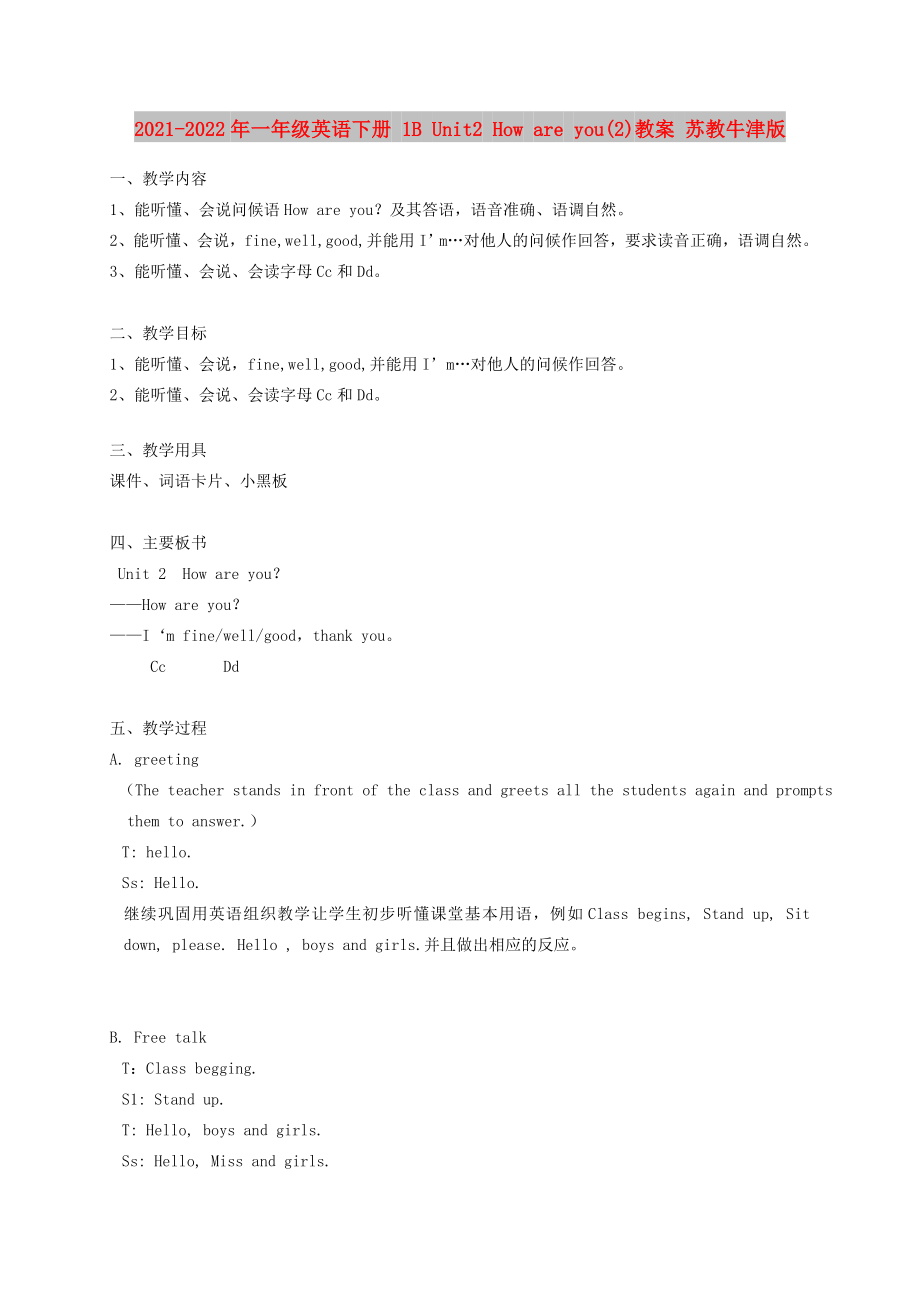《2021-2022年一年級(jí)英語下冊(cè) 1B Unit2 How are you(2)教案 蘇教牛津版》由會(huì)員分享���,可在線閱讀��,更多相關(guān)《2021-2022年一年級(jí)英語下冊(cè) 1B Unit2 How are you(2)教案 蘇教牛津版(5頁珍藏版)》請(qǐng)?jiān)谘b配圖網(wǎng)上搜索�����。
1��、2021-2022年一年級(jí)英語下冊(cè) 1B Unit2 How are you(2)教案 蘇教牛津版
一�、教學(xué)內(nèi)容
1、能聽懂����、會(huì)說問候語How are you���?及其答語���,語音準(zhǔn)確、語調(diào)自然�����。
2�����、能聽懂����、會(huì)說�,fine,well,good,并能用I’m…對(duì)他人的問候作回答�,要求讀音正確,語調(diào)自然�。
3、能聽懂��、會(huì)說��、會(huì)讀字母Cc和Dd�。
二、教學(xué)目標(biāo)
1����、能聽懂、會(huì)說�,fine,well,good,并能用I’m…對(duì)他人的問候作回答。
2���、能聽懂�、會(huì)說����、會(huì)讀字母Cc和Dd����。
三����、教學(xué)用具
課件、詞語卡片���、小黑板
四�、主要板書
2���、
Unit 2 How are you?
——How are you���?
——I‘m fine/well/good��,thank you�。
Cc Dd
五�����、教學(xué)過程
A. greeting
(The teacher stands in front of the class and greets all the students again and prompts them to answer.)
T: hello.
Ss: Hello.
繼續(xù)鞏固用英語組織教學(xué)讓學(xué)生初步聽懂課堂基本用語,例如Class begins, Stand up, Sit do
3���、wn, please. Hello , boys and girls.并且做出相應(yīng)的反應(yīng)��。
B. Free talk
T:Class begging.
S1: Stand up.
T: Hello, boys and girls.
Ss: Hello, Miss and girls.
T: What’s your name?
S1: Hello, my name is ….
T:How are you?
S1: I’m fine, thank you.
開起小火車����。
C.Look and learn
1)帶領(lǐng)學(xué)生讀準(zhǔn)每個(gè)單詞��。
2)可以利用所做的動(dòng)物頭飾
4��、�,結(jié)合A部分的教學(xué)內(nèi)容,進(jìn)行多種應(yīng)答����,如:
T:Hello, Miss Dog. How are you?
S: I’m fine, thank you. / I’m well, thank you. / I’m good, thank you.
3) 利用課堂實(shí)際情景,鼓勵(lì)學(xué)生用本部分新出現(xiàn)的教學(xué)內(nèi)容進(jìn)行靈活地應(yīng)答����。
D.Look and learn
1) 先復(fù)習(xí)一學(xué)過的字母Bb。
2)出示寫有字母Cc的卡片��,示范發(fā)音����,引導(dǎo)學(xué)生眼看教師口型����,聽清發(fā)音�。在靜聽?zhēng)妆楹螅倌7伦x音����。教字母Cc時(shí),采用分解因素的方法�,幫助學(xué)生發(fā)好字母的音。
3)同樣的方法教學(xué)字母Dd�����。
4)引
5�、導(dǎo)學(xué)生通過朗讀例詞cat和dog��, 進(jìn)一步感受字母在單詞中的發(fā)音����。
5)組織學(xué)生進(jìn)行大、小寫字母配對(duì)游戲���,將學(xué)生容易混淆的字母Bb和Dd放在一起比較�、辨認(rèn)。引導(dǎo)學(xué)生觀察不同字母的形狀��,鼓勵(lì)學(xué)生自己編順口溜���,加強(qiáng)記憶��。
E.Assign homework
(1)聽錄音����,進(jìn)行對(duì)話�����。
(2)鼓勵(lì)學(xué)生平時(shí)用本單元所學(xué)的日常交際用語相互打招呼����。
(3)鼓勵(lì)學(xué)有余力的學(xué)生學(xué)習(xí)其他的打招呼用語。
附送:
2021-2022年一年級(jí)英語下冊(cè) 1B Unit2 How are you(3)教案 蘇教牛津版
一���、教學(xué)內(nèi)容
1��、復(fù)習(xí)鞏固問候語How are you����?及其答語,要求讀音正確��,
6��、語調(diào)自然�。
2、復(fù)習(xí)鞏固句型: How are you����?I‘m fine/well/good,thank you�����。
3���、激發(fā)學(xué)生英語學(xué)習(xí)興趣��,會(huì)唱歌曲How are you�����?
4��、完成教學(xué)AB Uint2��。
二����、教學(xué)目標(biāo)
1��、培養(yǎng)學(xué)生學(xué)習(xí)英語的興趣�����。
2�、復(fù)習(xí)鞏固句型: How are you?I‘m fine/well/good�����,thank you��。
三��、教學(xué)用具
課件��、詞語卡片�、小黑板
四�����、主要板書
Unit 2 How are you�����?
——How are you�����?
——I‘m fine/well/good���,thank you。
7���、
五�、教學(xué)過程
A. greeting
(The teacher stands at the door and greets the students as they e in the door.)
T: Hello. Hi.
(The teacher stands in front of the class and greets all the students again and prompts them to answer.)
T: hello.
Ss: Hello.
T:Class begging.
S1: Stand up.
T: Hello,
8�、boys and girls.
Ss: Hello, Miss and girls.
(The teacher looks at individual students and prompts them to answer.)
T: What’s your name?
S1: Hello, my name is ….
T:How are you?
S1: I’m fine, thank you.
開起小火車,一個(gè)接一個(gè)和后面的小朋友打招呼��。
B. Presentation
When we meet someone, we should say “How are you?”
9�����、 Now, let’s watch and listen.
C. Sing a song
1) 反復(fù)播放How are you ?讓學(xué)生先熟悉曲調(diào)����。
2)帶領(lǐng)學(xué)生學(xué)歌詞,并按音樂節(jié)奏做歌詞誦讀練習(xí)�����。
3)帶領(lǐng)學(xué)生學(xué)唱歌曲�����。
4)引導(dǎo)學(xué)生替換歌詞��,如fine 可替換成well, good等��。
D. play a game
1) 課前布置學(xué)生找一個(gè)或者作一個(gè)自己喜愛的卡通形象的手偶���。
2)教師講解游戲的做法�,并進(jìn)行示范�����。
3)小組內(nèi)使用手偶開展對(duì)話游戲�,用學(xué)過的語言進(jìn)行交流:
S1: Good morning/ afternoon/ evening. What’s y
10��、our name?
S2: My name is …
S1: How are you?
S2: I’m fine/ well/ good. Thank you.
E. practice
(1)活動(dòng)1:Listen and judge.
教師先向?qū)W生解釋清楚題目的做法��。
——How are you ��, Helen?
——I’m fine , thank you.
請(qǐng)學(xué)生聽錄音��,要求學(xué)生根據(jù)錄音判斷對(duì)話內(nèi)容是否與圖畫意思一致��,相符則為笑 臉���,否則為哭臉。
(2)活動(dòng)2:listen and respond.
錄音中�����,畫面上的某個(gè)人物正在和另一個(gè)人打招呼��。根據(jù)圖片所示內(nèi)容用已學(xué)句型作出應(yīng)答���。
師生互問�,生生練習(xí)問答��。
(3)學(xué)習(xí)活動(dòng)3:listen and colour
要求學(xué)生在聽錄音后,根據(jù)錄音內(nèi)容將字母涂上合適的顏色����。
(4)學(xué)習(xí)活動(dòng)4:look and act
要求學(xué)生先看圖,然后依據(jù)圖意說英語并表演���。
教師組織學(xué)生操練句型。
——Is this David?
——No./…
F. Assign homework
(1)聽錄音��,進(jìn)行對(duì)話����。
(2)鼓勵(lì)學(xué)生平時(shí)用本單元所學(xué)的日常交際用語相互打招呼。
(3)鼓勵(lì)學(xué)有余力的學(xué)生學(xué)習(xí)其他的打招呼用語���。
 2021-2022年一年級(jí)英語下冊(cè) 1B Unit2 How are you(2)教案 蘇教牛津版
2021-2022年一年級(jí)英語下冊(cè) 1B Unit2 How are you(2)教案 蘇教牛津版

